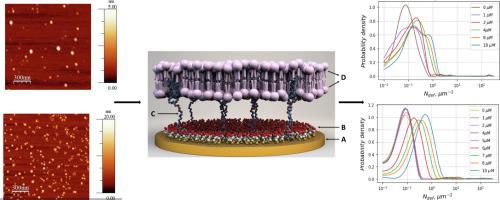Bioelectrochemistry ( IF 4.8 ) Pub Date : 2022-02-26 , DOI: 10.1016/j.bioelechem.2022.108091 Rima Budvytyte 1 , Filipas Ambrulevičius 1 , Evelina Jankaityte 1 , Gintaras Valincius 1

|
Amyloid beta (Aβ1-42) oligomers produced in vitro with and without the oligomerization inhibitor hexafluoroisopropanol (HFIP) were studied and compared as agents inflicting damage to the phospholipid bilayers. Tethered lipid membranes (tBLMs) of different compositions were used as model membranes. Dielectric damage of tBLMs by Aβ1-42 oligomers was monitored by the electrochemical impedance spectroscopy (EIS). Membranes containing sphingomyelin exhibited the highest susceptibility to Aβ1-42 oligomers when assembled in the absence of an inhibitor. The activation barrier of ion translocation through the Aβ1-42 oligomer entities in tBLMs was lowest in sphingomyelin membranes (<15 kJ/mol). This is consistent with the formation of water-filled, highly conductive (>50 pS) nanopores in tBLMs by Aβ1-42 oligomers assembled without HFIP. Conversely, HFIP-generated Aβ1- 42 oligomers exhibited conductance with high activation energies (>38 kJ/mol), suggesting the formation of assemblies with relatively narrow ion pores and the effective conductance in the range < 15 pS. Finally, the EIS data analysis revealed differences in the lateral distribution of Aβ1-42 oligomers in tBLMs. The inhibitor-free Aβ1-42 oligomers populate the tBLM surface in a random manner, whereas the HFIP-generated Aβ1-42 oligomers tend to cluster forming surface areas with markedly different densities of Aβ1-42 defects.
中文翻译:

淀粉样蛋白β-寡聚体对磷脂双层介电损伤的电化学评估
研究并比较了在体外使用和不使用寡聚化抑制剂六氟异丙醇 (HFIP)产生的β淀粉样蛋白 (Aβ 1-42 ) 寡聚体,并将其作为对磷脂双分子层造成损害的药剂进行比较。不同成分的栓系脂质膜(tBLM)被用作模型膜。通过电化学阻抗谱 (EIS) 监测Aβ 1-42低聚物对 tBLM 的介电损伤。在没有抑制剂的情况下组装时,含有鞘磷脂的膜对 Aβ 1-42寡聚体表现出最高的敏感性。离子易位通过 Aβ 1-42的激活屏障tBLM 中的寡聚体实体在鞘磷脂膜中最低(<15 kJ/mol)。这与在没有 HFIP 的情况下组装的 Aβ 1-42低聚物在 tBLM 中形成充水、高导电 (>50 pS) 纳米孔是一致的。相反,HFIP 生成的 Aβ 1-42低聚物表现出具有高活化能 (>38 kJ/mol) 的电导,表明形成了具有相对较窄的离子孔和有效电导范围 < 15 pS 的组件。最后,EIS 数据分析揭示了 tBLM中 Aβ 1-42寡聚体横向分布的差异。不含抑制剂的 Aβ 1-42寡聚体以随机方式填充 tBLM 表面,而 HFIP 生成的 Aβ 1-42低聚物倾向于聚集形成具有明显不同密度的 Aβ 1-42缺陷的表面区域。











































 京公网安备 11010802027423号
京公网安备 11010802027423号